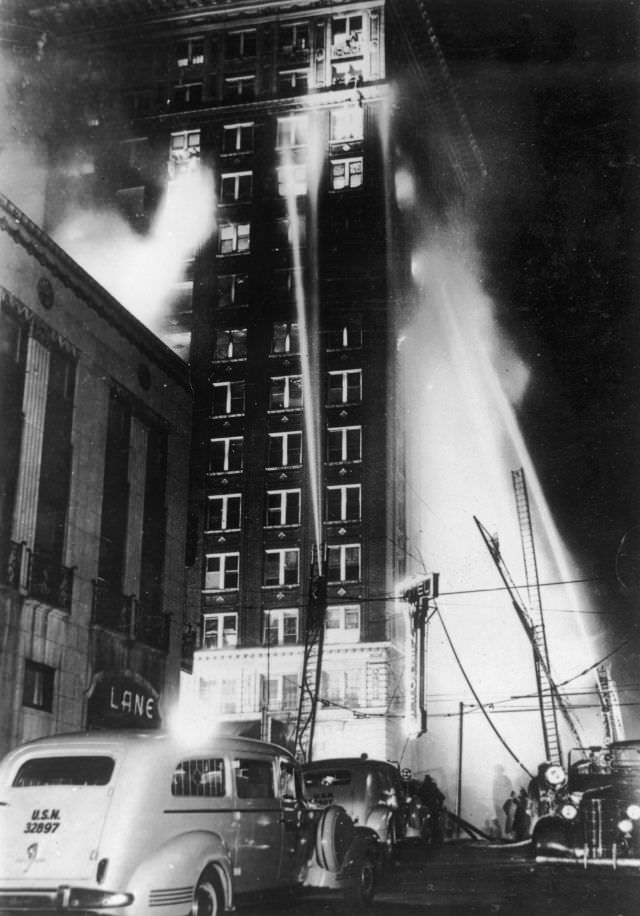The evening of December 6 had been like any other at Winecoff. The hotel was near capacity, hosting 280 guests, including high school students attending a Youth Assembly at the State Capitol, couples enjoying a weekend getaway, and businessmen in town for meetings.
The Winecoff Hotel, a 15-story high-rise structure, was marketed as “absolutely fireproof” when it was completed in 1913. Ironically, it was the fire safety claim that made the catastrophe even more devastating. The hotel lacked modern fire safety features such as fire escape stairs, fire doors, and sprinkler systems. Furthermore, the single stairway running up the building acted as a chimney, funneling the flames upwards.
At around 3:00 AM, the hotel’s night clerk first noticed smoke seeping into the lower-level lobby. He immediately called the fire department, unknowing that the blaze had already begun its rapid ascent, using the building’s single central staircase and elevator shafts as conduits.
Guests on the lower floors were woken by shouts and the sound of fire truck sirens. These fortunate few managed to escape the building through the main entrance. However, those on the upper floors, unaware of the burgeoning inferno below, were awakened by choking smoke and intense heat. With the central staircase consumed by flames, many guests found themselves trapped in their rooms. Panicked calls for help echoed down the smoke-filled corridors as guests realized the gravity of their situation. Some tried to fashion makeshift ropes from bed sheets, while others attempted to climb down the exterior of the building, only to lose their grip and plummet to the ground below.
Meanwhile, Atlanta’s fire department arrived promptly at the scene but faced a daunting challenge. Their ladders could only reach up to the eighth floor, leaving the remaining floors inaccessible. Firefighters valiantly tried to control the flames, their hoses creating arcs of water that scarcely reached the higher floors. On the ground, horrified spectators watched as trapped guests began to jump from the upper floors. The sight of falling bodies and the heart-rending cries of those trapped inside cast a pall of despair over the scene.


Death Leap from Blazing Hotel
During the chaos and terror, Arnold Hardy, an amateur photographer who happened to be at the right place at the right time, captured a poignant photograph that encapsulated the magnitude of the disaster. Hardy, a 24-year-old Georgia Tech graduate student who had never used a flash camera before that fateful night, saw the blaze while returning home and rushed to the scene with his camera. The photograph, titled “Death Leap from Blazing Hotel,” was taken by Hardy.

The photograph captured Daisy McCumber, a woman falling from the 11th floor of the burning hotel. She was one of the guests who decided to jump instead of being consumed by the fire. Miraculously, McCumber survived the fall but suffered severe injuries.
The gritty and raw photo deeply affected the public, shedding light on the horrifying truth of the Winecoff Hotel fire. It was published in newspapers nationwide, sparking a widespread demand for better safety regulations in hotels. In 1947, Arnold Hardy, the amateur photographer, received the Pulitzer Prize for Photography, becoming the first of his kind to be honored for such a chilling image.

The Winecoff Hotel fire and the “Death Leap from Blazing Hotel” photograph were instrumental in triggering a drastic overhaul of fire safety regulations across the United States. The incident led to the introduction of comprehensive fire codes that mandated the installation of fire alarms, sprinkler systems, multiple fire exits, and fire-resistant materials in hotels.
The tragedy also precipitated changes in the architectural design of high-rise buildings. The “life safety code” was adopted, which required the use of fire-resistant materials, fire doors, and multiple stairways. These changes undoubtedly saved countless lives in the subsequent years.
The public response to the disaster was significant. In the aftermath of the fire, people across the country donated money and supplies to assist the survivors and the families of the victims. This outpouring of support provided much-needed relief and displayed the solidarity of the American people in the face of tragedy.
Arnold Hardy’s photograph played a pivotal role in mobilizing this response. The haunting image of Daisy McCumber’s fall became a symbol of the disaster, eliciting empathy and shock. It humanized the tragedy, transforming it from a distant news story to a heart-wrenching reality that could no longer be ignored.
Today, the Winecoff Hotel, renamed the Ellis Hotel after extensive renovations, stands as a stark reminder of the 1946 tragedy. A plaque commemorating the victims of the fire is displayed in the hotel lobby, reminding us of the importance of safety regulations and the heavy price paid when they are overlooked.





